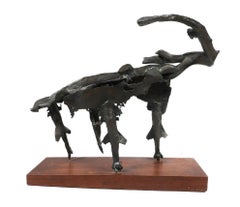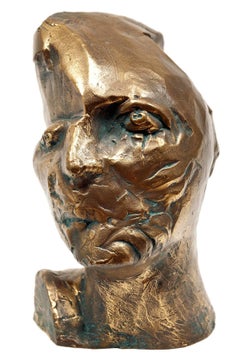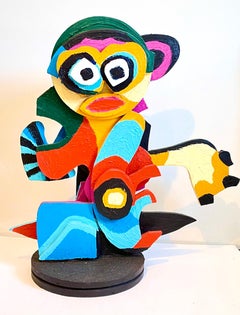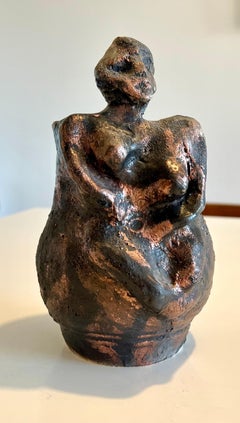Want more images or videos?
Request additional images or videos from the seller
1 of 6
Phillip PaviaUntitled, Head Of An Artist, Avant-Garde Bronze Sculpture1982
1982
Price:$8,000
$12,500List Price
About the Item
- Creator:Phillip Pavia (1912-2005, American)
- Creation Year:1982
- Dimensions:Height: 12.5 in (31.75 cm)Width: 8.5 in (21.59 cm)Depth: 9.5 in (24.13 cm)
- Medium:
- Movement & Style:
- Period:
- Condition:
- Gallery Location:Surfside, FL
- Reference Number:1stDibs: LU38211481972
About the Seller
4.9
Platinum Seller
Premium sellers with a 4.7+ rating and 24-hour response times
Established in 1995
1stDibs seller since 2014
1,810 sales on 1stDibs
Typical response time: 1 hour
Authenticity Guarantee
In the unlikely event there’s an issue with an item’s authenticity, contact us within 1 year for a full refund. DetailsMoney-Back Guarantee
If your item is not as described, is damaged in transit, or does not arrive, contact us within 7 days for a full refund. Details24-Hour Cancellation
You have a 24-hour grace period in which to reconsider your purchase, with no questions asked.Vetted Professional Sellers
Our world-class sellers must adhere to strict standards for service and quality, maintaining the integrity of our listings.Price-Match Guarantee
If you find that a seller listed the same item for a lower price elsewhere, we’ll match it.Trusted Global Delivery
Our best-in-class carrier network provides specialized shipping options worldwide, including custom delivery.You May Also Like
Brutalist Bronze Sculpture “La Nuit De Profil”
By Émile Antoine Bourdelle
Located in Dallas, TX
EMILE-ANTOINE BOURDELLE (French, 1861 - 1929).
La Nuit de profil (The Night in profile)
Conceived 1900-1904
Cast 1972
Patinated bronze
Interior signature "BY BOURDELLE."
Foundry st...
Category
Early 1900s Abstract Expressionist Figurative Sculptures
Materials
Bronze
$27,000
H 21.5 in W 12 in D 9 in
FAROLITO
By Nour Kuri
Located in Mexico City, MX
Couple in love synchrony
Category
2010s Abstract Expressionist Figurative Sculptures
Materials
Marble, Bronze
Torso XXXXL , Bronze/wood H 20 cm; L 30cm; W 20 cm
Located in Riga, LV
Ivars Miķelsons (1962)
Category
2010s Abstract Expressionist Figurative Sculptures
Materials
Bronze
$1,734 Sale Price
20% Off
H 7.88 in W 11.82 in D 7.88 in
Ivars Miķelsons (1962) , Bronze/wood H 38 cm; L 72cm; W 25 cm
Located in Riga, LV
Ivars Miķelsons (1962)
Category
2010s Abstract Expressionist Figurative Sculptures
Materials
Bronze
$3,468 Sale Price
20% Off
H 14.97 in W 28.35 in D 9.85 in
Ivars Miķelsons (1962) , Bronze H 138 cm; W28 cm; L28 cm
Located in Riga, LV
Ivars Miķelsons (1962)
Category
1990s Abstract Expressionist Figurative Sculptures
Materials
Bronze
$3,468 Sale Price
20% Off
H 53.94 in W 11.03 in D 11.03 in
Torso XXL , Bronze/wood H 15 cm; L 30cm; W 20 cm
Located in Riga, LV
Ivars Miķelsons (1962)
Category
2010s Abstract Expressionist Figurative Sculptures
Materials
Bronze
$1,734 Sale Price
20% Off
H 5.91 in W 11.82 in D 7.88 in
Paul Wunderlich - Leaf - Signed Bronze Sculpture
By Paul Wunderlich
Located in Collonge Bellerive, Geneve, CH
Paul Wunderlich
Leaf
Bronze Sculpture
Signed, Numbered 248/350
Dated 1979
Paul Wunderlich, (1927 - 2010)
Born in Eberswalde on 10 March 1927. The German painter studied at the K...
Category
1970s Abstract Expressionist Still-life Sculptures
Materials
Bronze
$5,539
H 13.78 in W 7.09 in D 3.94 in
Mountain High [Silver], Bronze
Located in San Francisco, CA
"Mountain High [Silver]'' is an edition bronze sculpture by Paul Braslow. This sculpture is hand-signed. He was an American sculptor and artist that established himself in the medium...
Category
2010s Abstract Expressionist Figurative Sculptures
Materials
Bronze
New York [Bronze], Bronze
Located in San Francisco, CA
"New York [Bronze]'' is an edition bronze sculpture by Paul Braslow. This sculpture is hand-signed. He was an American sculptor and artist that established himself in the medium of f...
Category
2010s Abstract Expressionist Figurative Sculptures
Materials
Bronze
Lilith-Red , Bronze
Located in San Francisco, CA
"Lilith-Red'' is an edition bronze sculpture by Paul Braslow. This sculpture is hand-signed. He was an American sculptor and artist that established himself in the medium of figurati...
Category
2010s Abstract Expressionist Figurative Sculptures
Materials
Bronze
More From This Seller
View AllBronze Sculpture Abstract Brutalist Goat or Ram WPA Artist Mounted on Base
By Benedict Michael Tatti
Located in Surfside, FL
Benedict Tatti (1917-1993) worked in New York city as a sculptor, painter, educator, and video artist. He studied stone and wood carving under Louis Slobodkin at the Roerich Museum. He later attended the Leonardo da Vinci School of Art studying under Attilio Piccirelli. In l939 he taught adult classes with the Teachers Project of the WPA and attended the Art Students League for three and a half years on full scholarship. He studied under William Zorach and Ossip Zadkine and later became Zorach’s assistant. Later in his career, he attended the Hans Hofmann School of Fine Arts. During World War II, Tatti served in the United States Army Air Force, where he spent three years assigned to variety of projects. In 1948, Benedict Tatti married Adele Rosenberg in New York City.
Throughout his career, Tatti continuously experimented with various media. From 1952-1963, Tatti executed sculptural models of architectural and consumer products for the industrial designers, Raymond Loewy Associates; later he became a color consultant for the firm. In the 1960s, influenced by the Abstract Expressionists, Tatti turned from carving directly in wood and stone to creating assemblage architecture sculptures, using bronze metal and other industrial materials.
He was included in the important show "Aspects de la Sculpture Americaine", at Galerie Claude Bernard Paris, France, in October 1960 along with Ibram Lassaw, Theodore Roszak, David Smith, Louise Bourgeois, Danese Corey, Dorothy Dehner, Lin Emery, Lily Ente, David Hayes, Louise Nevelson, Tony Rosenthal, Richard Stankiewicz, Sam Szafran...
Category
Mid-20th Century Abstract Expressionist Abstract Sculptures
Materials
Bronze
Untitled, Head Of An Artist, Avant-Garde Bronze Sculpture
By Phillip Pavia
Located in Surfside, FL
This is a bronze cast sculpture by Philip Pavia is part of his series of "Imaginary Portraits from the Club" , a one-man exhibition at Max Protetch Gallery, New York in 1982. The approach at rendering the figure is grotesque, and the facial features have been severely distorted to the point were the portrait becomes an abstract interpretation of the subject.
As an artist and writer, Philip Pavia was a committed member of the Abstract Art community throughout his long, distinguished career. Pavia was active in the art world until his death in 2005 and received immense critical praise for his artistic and literary contributions. Recognized for his signature work The Ides of March...
Category
20th Century Abstract Expressionist Figurative Sculptures
Materials
Bronze
Karel Appel Colorful Expressionist Hand Painted Wood Cobra Sculpture Pop Art
By Karel Appel
Located in Surfside, FL
This is an original wooden sculpture with hand painting on both sides. it does not appear to be signed or numbered and does not currently have any label. I believe this might be the ...
Category
1970s Abstract Expressionist Abstract Sculptures
Materials
Wood, Paint
Brutalist Ceramic Sculpture Vase Bronze Lustre FInish California Expressionist
By Jenik Cook
Located in Surfside, FL
Jenik Cook
Handmade ceramic vase or pot sculpture
Hand signed by the artist.
Fired clay with a luster bronze painted finish
Jenik Esterm Simonian Cook is a painter and ceramicist ...
Category
20th Century Abstract Expressionist Figurative Sculptures
Materials
Ceramic, Luster, Paint
Large Latin American Modernist Bronze Abstract Cuban Master Roberto Estopinan
By Roberto Estopiñan
Located in Surfside, FL
Roberto Estopinan, Cuban, 1920 - 2015
Dimensions: 24.5" wide x 13" high plus 6" high base.
Roberto Estopiñán (1921–2015) was a Cuban American sculptor known for his sculptures of the human form, including political prisoners. Born in Camaguey, Cuba, he lived in the United States for over fifty years. His works are held by major institutions such as the Museum of Modern Art, the Whitney Museum and the Smithsonian Museum of American Art.
Roberto Gabriel Estopinan, a sculptor, draftsman, and printmaker, was born in Havana, Cuba on March 18, 1921. Estopiñán enrolled at the San Alejandro Academy when he was just 14 years old and became the protegé and studio assistant of the sculptor Juan José Sicre. After graduation he traveled first to Mexico, where he met and befriended Francisco Zuniga, and studied Pre-Columbian sculpture. In 1949 he traveled to Europe, visiting England, France and Italy. In these trips he encountered the sculpture of Henry Moore and Marino Marini, and their humanistic yet formal visions would be influential on Estopinan's work. Estopiñán was a pioneer of direct carvings using wood and of welding techniques in Latin America. Throughout the 1950s, Estopiñán received important prizes at various national exhibitions in Havana. In 1953 he was the only semi-finalist from Latin America at the Tate Gallery's international sculpture competition for a Monument to the Unknown Political Prisoner. In 1961, the artist moved to New York, where he resided until 2002.
Roberto Gabriel Estopiñán a Cuban emigre sculptor who emigrated to exile in the United States not long after Fidel Castro’s revolution in 1959, is considered one of Latin America’s most important 20th-century artists. His work, which includes drawings and prints as well as sculptures in wood and bronze, is in the collections of New York’s Museum of Modern Art, the Smithsonian’s American Art Museum, the Art Institute of Chicago, and the Detroit Institute of Art, among many locations. He is best known for his stark, disturbing renderings of political prisoners, the fruit of his own experiences as a dissident under both Castro and his predecessor, the dictator Fulgencio Batista, and for his representations of the female torso that can remind viewers of both classical statuary and the high-modern, abstractly elongated work of Henry Moore.mHe was born in Havana to a father from Asturias in northwest Spain and a mother of African descent. Estopiñán was something of a prodigy. At the age of fourteen, he won the first prize in drawing at the Centro Asturiano, a regional association for Cubans of Asturian descent. Shortly afterward he received special permission to enter the San Alejandro Academy of Fine Arts in Havana. At the school he was mentored first by its director, the painter Armando Menocal (1863-1941), then by the landscape artist Antonio Rodríguez Morey (1872-1967), and finally by Juan José Sicre (1898-1974), regarded as one of Cuba’s greatest sculptors. Sicre, a professor of sculpture at the Academy, had helped introduce European modernist art to Cuba, and from the 1930s through the 1950s had sculpted monumental figures in Havana of José Martí and other Cuban national heroes that stand to this day. Estopiñán was first Sicre’s student, then his assistant, and, finally, his colleague for the next fifty years. After graduating from San Alejandro in 1942, Estopiñán began simultaneously teaching art at the Ceiba del Agua School for young men, assisting Sicre in public art projects and developing his own artistic vision. He also traveled widely, to Mexico, New York, France, and Italy. From the late 1940s through the 1950s his sculpture evolved from an early neoclassical phase under the influence of Maillol to what he defined as “formalist humanism”: emphasizing the abstract beauty of the shapes he sculpted while not abandoning the human figure as the basis of his work. As the 1950s progressed he chose to carve in native Cuban woods...
Category
20th Century Abstract Figurative Sculptures
Materials
Bronze
French Pop Art Heavy Bronze Sculpture Chess Game Gambit Arman Accumulation
By Arman
Located in Surfside, FL
Arman, French American (1928-2005)
Gambit (Chess pieces)
Cast Bronze Sculpture with patina
Incised signature near lower edge, 48/70 with
impressed "Bronze Romain & Fils" foundry ma...
Category
Early 2000s Abstract Figurative Sculptures
Materials
Bronze
Recently Viewed
View AllMore Ways To Browse
Sculpture 6ft
Phillips Bronze Sculpture
Wire Suspended Sculptures
Yuki Gray
24inch Bronze Sculpture
Abell Octovan
Alfonso Castillo Orta
Alhambra Facade
Alhambra Gesso
Alhambra Plaque
Andrew Kazantsev
Anton Chotka
Baby Yoda
Bearbrick 1000 Haring
Bearbrick Kaws Dissected
Bearbrick Keith Haring 1000
Beto Gatti
Bill Mack Bronze Art



